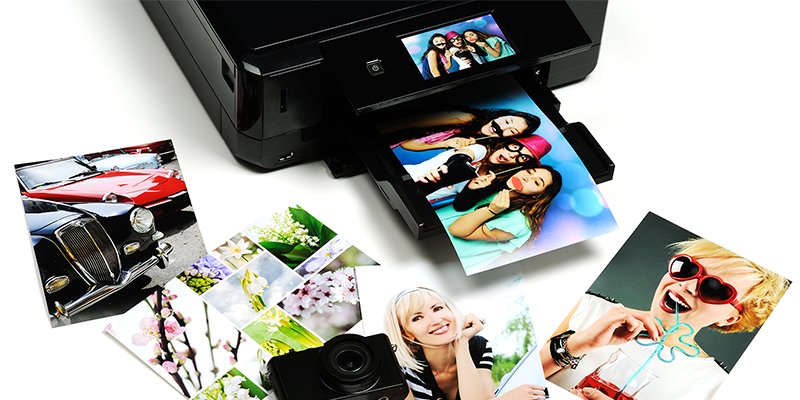Which photo printer should I buy?
The huge benefit of home printing is that it is almost instant – you can get prints up on the wall five minutes after you have take them. It can be expensive, though, because while the printer itself may not cost that much to buy the manufacturers make up for it with the cost of ink.
What type of printer to buy?
Before you buy a printer you need to ask yourself a few questions about your printing habits:
How much photo printing are you going to do?
If you are going to send almost all of your photographs off to a lab to be printed (including your 6x4-inch family album prints), then you may well be able to make do with whatever general printer you already have for the odd print or two that you want to make at home. The photo quality may not be great, but you can quickly get a display up on the wall. However, if you intend to do most of your printing yourself and you want better quality and archival prints that will not fade you will need to start looking at dedicated inkjet photo printers.
Photo printer or all-in-one?
Some printers are dedicated to making photo-quality prints, while others are ‘all-in-one’ devices that allow you to print, scan and make photocopies. This is useful if you want to use your printer for office admin, as well as printing your photographs, but it is worth remembering that inkjet printers are an expensive way of printing office documents. Also, they may not produce the same high-quality photographic prints as a dedicated photo printer, so you might end up needing two printers: one for admin and one for photographs.
Size of print
If you only want to make snapshot-sized, 6x4-inch prints there are plenty of suitable small-format printers out there, many of which are portable. Most photographers will want to make larger prints, though, and will choose to invest in a desktop photo printer. The majority of these will make prints up to A4 in size, but there are also larger desktop printers that will make A3- or even A2-sized prints (although you will need a big desk!). Once you start printing bigger than A2 you will be looking at freestanding industrial-level printers, which typically use a roll of paper rather than individual sheets. These larger printers need an advanced knowledge of end-to-end colour calibration, as mistakes are very expensive in terms of ink and paper costs.
Fun printers
At the time of writing, the Fuji Instax, Canon IVY and HP Sprocket are three pocket-sized mini printers that will make 3x2-inch prints. The images are fun and shareable, with a range of different papers to print on, including stickers, fabric transfers and magnetic paper, as well as ‘normal’ photographic paper. The prints they make are of ‘good enough’ quality, but are not archival.
Which make to buy?
Epson and Canon traditionally make the best photo printers in terms of print quality and archival properties.
Which paper to use?
Printers are manufactured to work optimally with the same brand of paper and ink. In fact, the paper is often integral to the process so if, for example, you use Epson paper with Canon ink, you can get unusual results. However, while the printer manufacturers do not guarantee the print quality or archival properties if you use third-party paper there are plenty of alternative paper manufacturers around. Many of them produce fantastic printing papers, so don’t feel you can only buy paper from your printer manufacturer.
Good photo printing is not as simple as putting paper in and pressing ‘Print’. To start with, you need to tell the printer which paper you are using. If you are using paper that matches the printer (for example, Canon paper in a Canon printer) there should be a drop-down menu in the print dialogue box that lets you pick your specific paper type. If it is not there, you may need to update your printer driver.
If you are using a third-party paper that doesn’t appear on the drop-down list, you should (at the very least) be able to specify whether you are using glossy or matte paper. A far better option is to use ICC profiles, which adjust the printer settings so you get the highest quality image. Full instructions on how to download and install these profiles can be found on each paper manufacturer's website.
Which ink to use?
As with paper, printers are designed to use the same manufacturer’s ink. In fact, using third-party inks may invalidate the printer’s warranty, produce prints that aren’t archival and could risk clogging the fine nozzles in the printer’s head.
Some printers use four inks (cyan, magenta, yellow and black), which come in two cartridges (colour and black), but advanced photo printers will typically have more colours and use individual cartridges for each one. The benefit of more colours is that the printer will be capable of better colour reproduction, while having individual cartridges means each one can be replaced as its runs out, rather than you having to replace a pack of multiple colours just because a single colour has run out.
If you want to do black-and-white printing it is worth checking how many black inks a printer uses. At the time of writing, Epson’s top-of-the range home printer uses two black inks and two grey inks (among its total of 10 cartridges), which promises smoother tonal gradations and deeper blacks in monochrome prints.
JOIN A YEAR WITH MY CAMERA
This blog post is taken from A Second Year With My Camera, Emma’s intermediate photography course which will be available on Amazon at the end of 2021. To join the email preview for AYWMC2 click here:
If you’re not ready for the intermediate course yet, you can join the first A Year With My Camera and start from the very beginning here:


